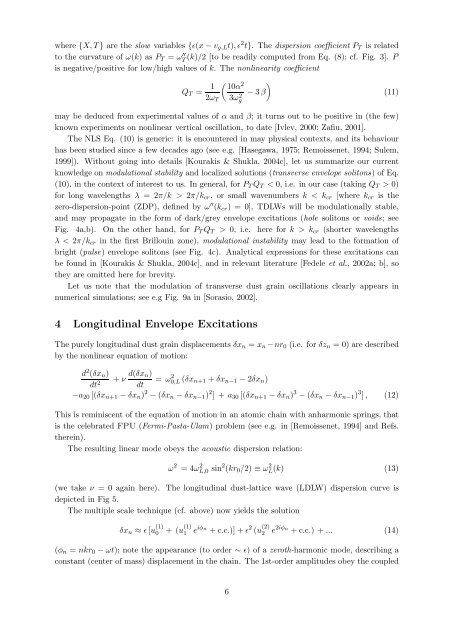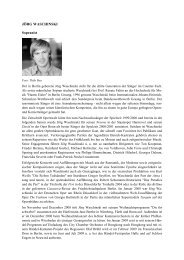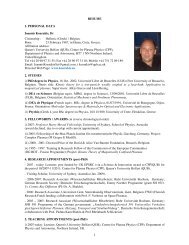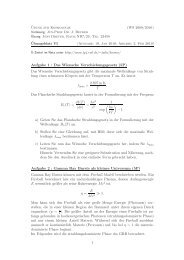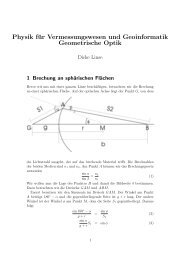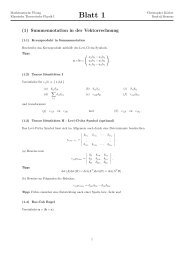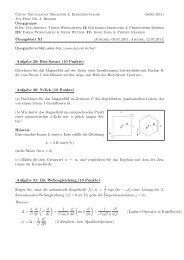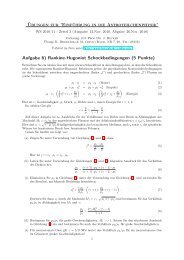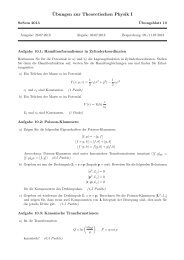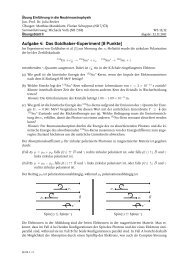View - Theoretische Physik IV - Ruhr-Universität Bochum
View - Theoretische Physik IV - Ruhr-Universität Bochum
View - Theoretische Physik IV - Ruhr-Universität Bochum
Create successful ePaper yourself
Turn your PDF publications into a flip-book with our unique Google optimized e-Paper software.
where {X,T } are the slow variables {ɛ(x − v g,L t),ɛ 2 t}. The dispersion coefficient P T is related<br />
to the curvature of ω(k) as P T = ω T ′′ (k)/2 [to be readily computed from Eq. (8); cf. Fig. 3]. P<br />
is negative/positive for low/high values of k. The nonlinearity coefficient<br />
Q T = 1 ( 10α<br />
2 )<br />
2ω T 3ωg<br />
2 − 3β<br />
may be deduced from experimental values of α and β; it turns out to be positive in (the few)<br />
known experiments on nonlinear vertical oscillation, to date [Ivlev, 2000; Zafiu, 2001].<br />
The NLS Eq. (10) is generic: it is encountered in may physical contexts, and its behaviour<br />
has been studied since a few decades ago (see e.g. [Hasegawa, 1975; Remoissenet, 1994; Sulem,<br />
1999]). Without going into details [Kourakis & Shukla, 2004c], let us summarize our current<br />
knowledge on modulational stability and localized solutions (transverse envelope solitons) of Eq.<br />
(10), in the context of interest to us. In general, for P T Q T < 0, i.e. in our case (taking Q T > 0)<br />
for long wavelengths λ = 2π/k > 2π/k cr , or small wavenumbers k < k cr [where k cr is the<br />
zero-dispersion-point (ZDP), defined by ω ′′ (k cr ) = 0], TDLWs will be modulationally stable,<br />
and may propagate in the form of dark/grey envelope excitations (hole solitons or voids; see<br />
Fig. 4a,b). On the other hand, for P T Q T > 0, i.e. here for k > k cr (shorter wavelengths<br />
λ < 2π/k cr in the first Brillouin zone), modulational instability may lead to the formation of<br />
bright (pulse) envelope solitons (see Fig. 4c). Analytical expressions for these excitations can<br />
be found in [Kourakis & Shukla, 2004c], and in relevant literature [Fedele et al., 2002a; b], so<br />
they are omitted here for brevity.<br />
Let us note that the modulation of transverse dust grain oscillations clearly appears in<br />
numerical simulations; see e.g Fig. 9a in [Sorasio, 2002].<br />
(11)<br />
4 Longitudinal Envelope Excitations<br />
The purely longitudinal dust grain displacements δx n = x n −nr 0 (i.e. for δz n = 0) are described<br />
by the nonlinear equation of motion:<br />
d 2 (δx n )<br />
dt 2 + ν d(δx n)<br />
= ω0,L 2 dt<br />
(δx n+1 + δx n−1 − 2δx n )<br />
−a 20 [(δx n+1 − δx n ) 2 − (δx n − δx n−1 ) 2 ] + a 30 [(δx n+1 − δx n ) 3 − (δx n − δx n−1 ) 3 ], (12)<br />
This is reminiscent of the equation of motion in an atomic chain with anharmonic springs, that<br />
is the celebrated FPU (Fermi-Pasta-Ulam) problem (see e.g. in [Remoissenet, 1994] and Refs.<br />
therein).<br />
The resulting linear mode obeys the acoustic dispersion relation:<br />
ω 2 = 4ω 2 L,0 sin 2 (kr 0 /2) ≡ ω 2 L(k) (13)<br />
(we take ν = 0 again here). The longitudinal dust-lattice wave (LDLW) dispersion curve is<br />
depicted in Fig 5.<br />
The multiple scale technique (cf. above) now yields the solution<br />
δx n ≈ ɛ[u (1)<br />
0 + (u (1)<br />
1 e iφn + c.c.)] + ɛ 2 (u (2)<br />
2 e 2iφn + c.c.) + ... (14)<br />
(φ n = nkr 0 − ωt); note the appearance (to order ∼ ɛ) of a zeroth-harmonic mode, describing a<br />
constant (center of mass) displacement in the chain. The 1st-order amplitudes obey the coupled<br />
6


